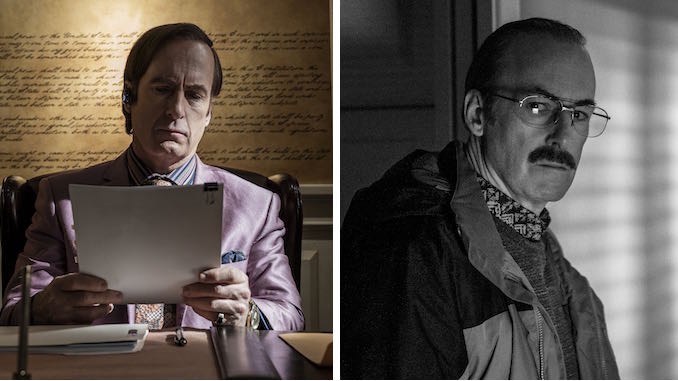Exploring Better Call Saul‘s Mastery of the Time Cut
Photo Courtesy of AMC
The opening scene of Better Call Saul’s finale is a flashback, but only to 15 episodes ago. We see a brief new scene taking place at the time of Season 5’s “Bagman,” where Jimmy and Mike traipse through the desert carrying Lalo Salamanca’s bail money, before coming across an oasis of clean water to quench their thirst. They talk about building a time machine, and what they’d use it for. Mike is stuck on stopping moral rot ever taking hold over him, Jimmy is more interested in personal gain. It’s a great character beat in an episode about regret (is Jimmy ever capable of changing the way he thinks?), but structurally, it’s one of the last flourishes of a core motif of the show, one that became more prominent in the nonlinear final stretch. Better Call Saul, in navigating three distinct timelines, has steadily become the master of a writing technique that has the potential to cause its viewer whiplash, alertness, and emotional devastation: the time cut.
Time cuts occur in pretty much all film and television, as few stories entirely take place in real time, but the more noticeable they are, the more they affect the structure and enjoyment of a show. The type of time cut I’m referring to happens when a huge decision or climax happens to a character, but rather than continuing after its resolution, we next see our characters deep in the future, far away from the previous events, never revisiting what happened. It’s sort of the opposite of a cliffhanger—instead of having to wait ages to see the very next moments of a scene, in mere moments we’re flung to a far distant, removed time. You feel a lurch inside you, a thousand questions spinning in your head as different locations, different situations, and different conflicts take you somewhere else.
The emotional effect is shock, but more than that it communicates a definite melancholy. All that time we’re not privy to, what could have happened then? If we don’t see a story, we’re conditioned to think none occurred: our characters stayed the same, stuck in limbo, perfectly content or slightly miserable, until we pick up with them again. But worse is the fear that they continued down a path we didn’t want them to; maybe the one where they ended up with the wrong person, or regressed into someone we don’t want them to be.
A time cut is what happens when the immediate drama feels resolved, but only for so long—the themes persist, waiting until they can force conflict back onto their characters. Think about in Normal People when high schooler Connell tells Maryanne over the phone that he loves her: we cut to the episode’s credits, and join him again months later starting university alone. They’re not together! Remember in Fargo Season 1 where, after Molly has to make her peace with her case not being solved, we cut to a year later and join Lester Nygaard receiving a lovely award, now with a new wife and a gorgeous lakeside house? Good did not prevail over evil! And do I even need to mention The Leftovers finale?! It hammers home the relentlessness of time; we don’t have the chance to catch up, we can’t do things over, and we’re not able to keep a watchful eye over our characters. Deal with it, the time cut says.
Better Call Saul’s main timeline was effectively over by the end of Episode 9. Since then, we’ve enjoyed flashbacks to Breaking Bad’s timeline, early moments in Better Call Saul, as well as forging ahead with the black-and-white adventures of “Gene” post-Breaking Bad, indulging in season prologues that are ultimately epilogues. The finale, “Saul Gone,” with regular reference to time travel (including a flashback-Chuck reading the most famous novel on the subject), lets us see how the biggest players in Jimmy’s life (and cast members of Breaking Bad he’s never met!) view the subject of regret and change. Its numerous time cuts give the sense of looking back, a feeling that ruminates in the three episodes that precede it. There’s often snapshots of Jimmy as Saul, as Gene, committing to his apocryphal phoneyness or being tempted back into the only life where he ever felt in control. When we leap from Kim telling Jimmy it’s over to him in his Saul-mansion, and again then to the stirrings of his Gene scams, we’re reminded that, of course, the happy ending we’ve all been wishing for was never going to materialize.
-

-

-

-

-

-

-

-

-

-

-

-

-

-

-

-

-

-

-

-

-

-

-

-

-

-

-

-

-

-

-

-

-

-

-

-

-

-

-

-








































